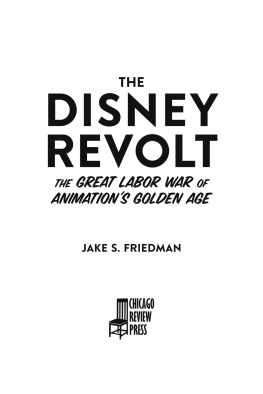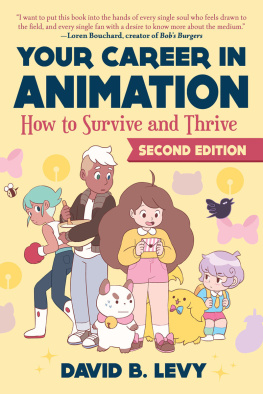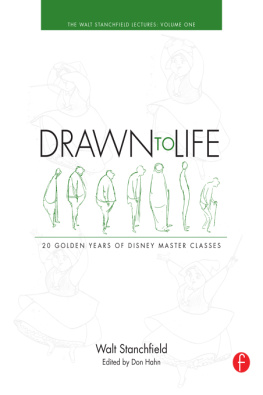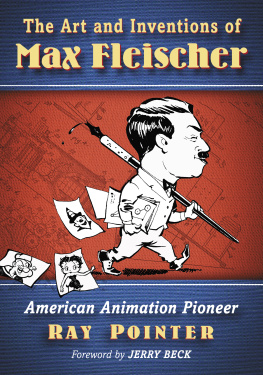David Whitley - The Idea of Nature in Disney Animation
Here you can read online David Whitley - The Idea of Nature in Disney Animation full text of the book (entire story) in english for free. Download pdf and epub, get meaning, cover and reviews about this ebook. year: 2012, publisher: Ashgate Publishing, genre: Science. Description of the work, (preface) as well as reviews are available. Best literature library LitArk.com created for fans of good reading and offers a wide selection of genres:
Romance novel
Science fiction
Adventure
Detective
Science
History
Home and family
Prose
Art
Politics
Computer
Non-fiction
Religion
Business
Children
Humor
Choose a favorite category and find really read worthwhile books. Enjoy immersion in the world of imagination, feel the emotions of the characters or learn something new for yourself, make an fascinating discovery.

- Book:The Idea of Nature in Disney Animation
- Author:
- Publisher:Ashgate Publishing
- Genre:
- Year:2012
- Rating:5 / 5
- Favourites:Add to favourites
- Your mark:
- 100
- 1
- 2
- 3
- 4
- 5
The Idea of Nature in Disney Animation: summary, description and annotation
We offer to read an annotation, description, summary or preface (depends on what the author of the book "The Idea of Nature in Disney Animation" wrote himself). If you haven't found the necessary information about the book — write in the comments, we will try to find it.
The Idea of Nature in Disney Animation — read online for free the complete book (whole text) full work
Below is the text of the book, divided by pages. System saving the place of the last page read, allows you to conveniently read the book "The Idea of Nature in Disney Animation" online for free, without having to search again every time where you left off. Put a bookmark, and you can go to the page where you finished reading at any time.
Font size:
Interval:
Bookmark:
THE IDEA OF NATURE IN DISNEY ANIMATION: FROM SNOW WHITE TO WALLE
In the second edition of The Idea of Nature in Disney Animation, David Whitley updates his 2008 book to reflect recent developments in Disney and Disney-Pixar animation such as the apocalyptic tale of earths failed ecosystem, WALLE. As Whitley has shown, and Disneys newest films continue to demonstrate, the messages animated films convey about the natural world are of crucial importance to their child viewers. Beginning with Snow White, Whitley examines a wide range of Disneys feature animations, in which images of wild nature are central to the narrative. He challenges the notion that the sentimentality of the Disney aesthetic, an oft-criticized aspect of such films as Bambi, The Jungle Book, Pocahontas, Beauty and the Beast and Finding Nemo, necessarily prevents audiences from developing a critical awareness of contested environmental issues. On the contrary, even as the films communicate the central ideologies of the times in which they were produced, they also express the ambiguities and tensions that underlie these dominant values. In distinguishing among the effects produced by each film and revealing the diverse ways in which images of nature are mediated, Whitley urges us towards a more complex interpretation of the classic Disney canon and makes an important contribution to our understanding of the role popular art plays in shaping the emotions and ideas that are central to contemporary experience.
Ashgate Studies in Childhood, 1700 to the Present
Series Editor: Claudia Nelson, Texas A&M University
This series recognizes and supports innovative work on the child and on literature for children and adolescents that informs teaching and engages with current and comparative studies by humanities scholars working in a variety of fields, including literature; book history, periodicals history, and print culture and the sociology of texts; theater, film, musicology, and performance studies; history, including the history of education; gender studies; art history and visual culture; cultural studies; and religion.
From Snow White to WALLE Second Edition
DAVID WHITLEY
University of Cambridge, UK
ASHGATE
David Whitley 2012
First published in hardback 2008
All rights reserved. No part of this publication may be reproduced, stored in a retrieval system or transmitted in any form or by any means, electronic, mechanical, photocopying, recording or otherwise without the prior permission of the publisher.
David Whitley has asserted his right under the Copyright, Designs and Patents Act, 1988, to be identified as the author of this work.
Published by
Ashgate Publishing Limited
Wey Court East
Union Road
Farnham
Surrey, GU9 7PT
England
Ashgate Publishing Company
Suite 420
101 Cherry Street
Burlington
VT 05401-4405
USA
www.ashgate.com
British Library Cataloguing in Publication Data
Whitley, David.
The idea of nature in Disney animation: from Snow White to WALL-E. 2nd ed. (Ashgate studies in childhood, 1700 to the present)
1. Disney, Walt, 19011966 Themes, motives. 2. Walt Disney Company. 3. Animated films United States History and criticism. 4. Nature in motion pictures.
I. Title II. Series
791.4334dc23
Library of Congress Cataloging-in-Publication Data
Whitley, David.
The idea of nature in Disney animationfrom Snow White to WALL-E / by David Whitley. Second Edition.
pages cm (Ashgate studies in childhood, 1700 to the present)
Includes bibliographical references and index.
1. Disney, Walt, 19011966Criticism and interpretation. 2. Nature in motion pictures. 3. Animated films and childrenUnited States. 4. Animated filmsPsychological aspects. 5. Animated filmsSocial aspectsUnited States. I. Title.
NC1766.U52D594 2012
791.4366dc23
2012006283
ISBN 9781409437482 (hbk)
ISBN 9781409437499 (pbk)
ISBN 9781409437505 (ebk)
ISBN 9781409479383 (ebk-ePUB)
Where is the voice of nature calling us? Back to a
pre-modern age? Or forward to a saner future?
Theodore Adorno
I am grateful for the warm support offered by all my colleagues in the English and Drama team at Homerton College and the Faculty of Education, Cambridge University. Special thanks need to go to Mary Hilton, whose encouragement and suggestions have been invaluable, and to Eve Bearne, whose support for my writing (and that of many others) over the years has been matchless. I would also like to thank Michael Bonnett for his generous response to an early version of the chapter on Bambi. It has been a pleasure working with the Ashgate team but I am particularly grateful to Ann Donahue, who has answered every query and anxiety that I have put to her with great patience, clarity and good humour, and to Kathy Bond Borie, who has been a model of efficiency and tact in completing the new edition. And I very much appreciate the work put in by Ruth Suggett, Louise Radcliffe and Jenny Knight, who helped sort out technical details of the project in its later stages. Perhaps most of all, I would like to thank my family; my wife, Rosie, for the positive support she has offered throughout (and for putting up with my distractedness); and my children, Jack, Eve and Beth, for sharing aspects of their delight and understanding of film as they have grown up. I would not have felt in touch with the quality of experience offered by Disney animation in the same way without them. Special thanks go to Beth, who shares my enthusiasm for the animated medium and who watched many of the films with me as I was researching the book.
Wild Sentiment: The Theme of Nature in Disney Animation
Disneys films are a revolt against partitioning and legislating, against spiritual stagnation and greyness. But the revolt is lyrical. The revolt is a daydream.
Sergei Eisenstein, Eisenstein on Disney
This book takes a fresh look at Disney animated films, seen from the particular perspective of their engagement with the theme of wild nature. This theme, I shall argue, was of central importance from the moment Disney first ventured fatefully into the form of the animated feature in 1937. Grafted onto the root-stem of fairy tale and linked predominantly to the plotline of maturation within romantic comedy, the theme of wild nature forms the very heartland of Disneys animated features from their inception in Snow White through to recent films such as Finding Nemo and Brother Bear. Not all of Disneys animated feature films focus centrally on wild creatures or natural environments, of course. Indeed this provides a useful principle of exclusion, enabling the films considered in detail in this study to be narrowed down to manageable proportions. But the theme is prevalent enough to make a claim for its centrality justifiable and even those films outside the realm of this study which feature domesticated animals or humans as their sole protagonists are often concerned with contrasts between the natural and the human in their assessments of behaviour. Cruella De Vil is not the only figure in Disney whose characteristic brutality is made to contrast with animals (and animal lovers) who have an affinity with the natural world. In many of the most famous and best loved Disney films, however such as Snow White, Bambi, The Jungle Book, The Lion King and Finding Nemo wild nature figures directly and it is with these films that I shall be principally concerned.
Next pageFont size:
Interval:
Bookmark:
Similar books «The Idea of Nature in Disney Animation»
Look at similar books to The Idea of Nature in Disney Animation. We have selected literature similar in name and meaning in the hope of providing readers with more options to find new, interesting, not yet read works.
Discussion, reviews of the book The Idea of Nature in Disney Animation and just readers' own opinions. Leave your comments, write what you think about the work, its meaning or the main characters. Specify what exactly you liked and what you didn't like, and why you think so.







